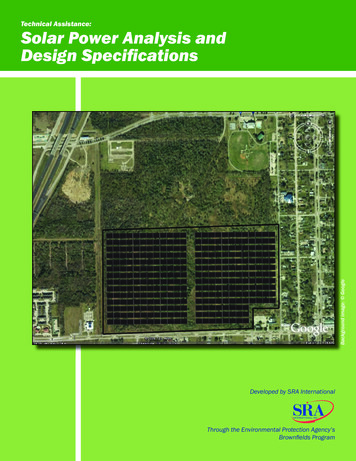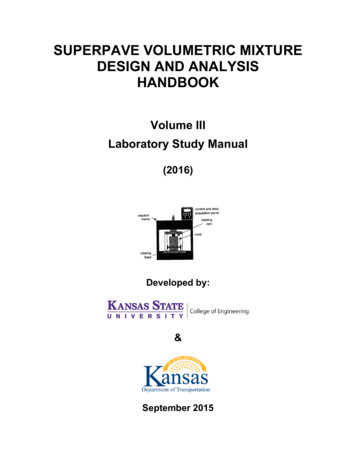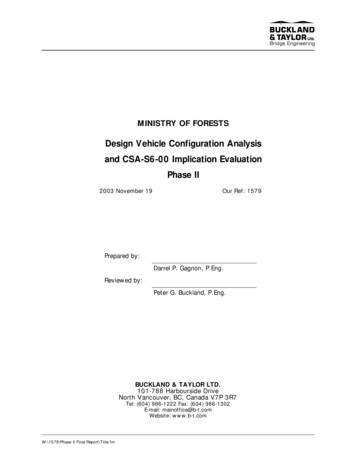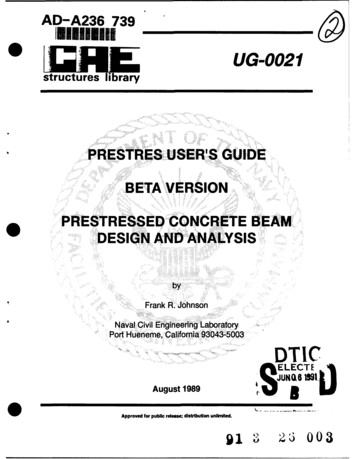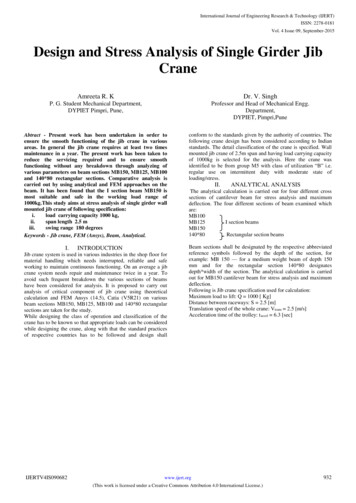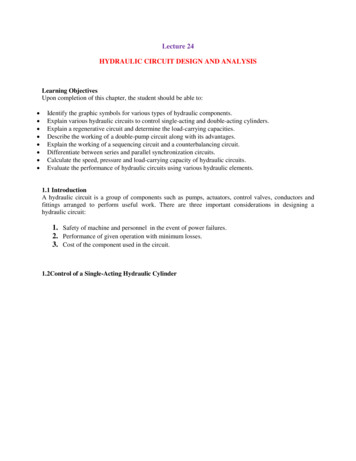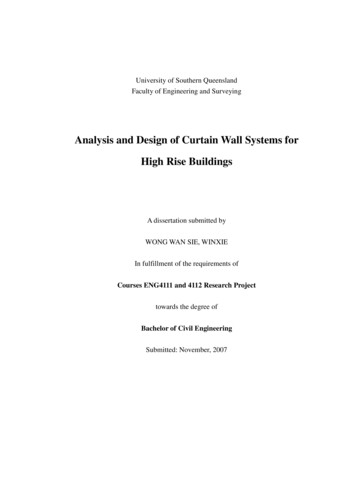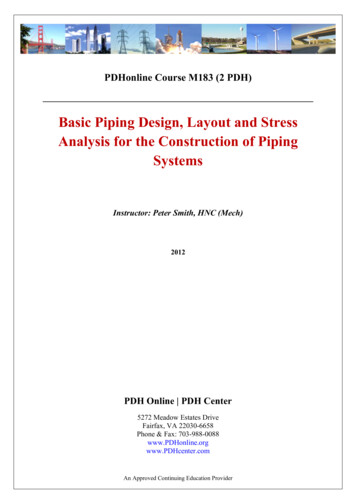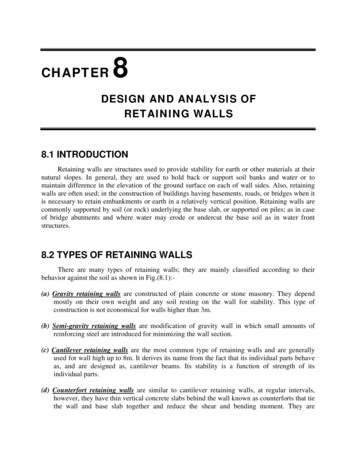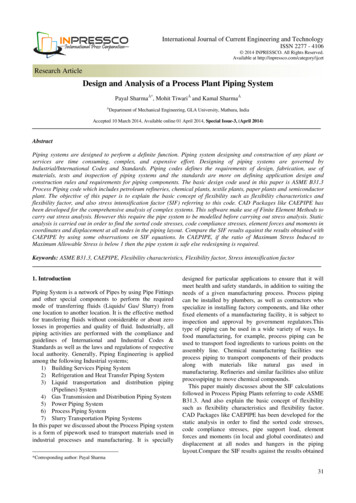
Transcription
International Journal of Current Engineering and TechnologyISSN 2277 - 4106 2014 INPRESSCO. All Rights Reserved.Available at http://inpressco.com/category/ijcetResearch ArticleDesign and Analysis of a Process Plant Piping SystemPayal SharmaȦ*, Mohit TiwariȦ and Kamal SharmaȦȦDepartment of Mechanical Engineering, GLA University, Mathura, IndiaAccepted 10 March 2014, Available online 01 April 2014, Special Issue-3, (April 2014)AbstractPiping systems are designed to perform a definite function. Piping system designing and construction of any plant orservices are time consuming, complex, and expensive effort. Designing of piping systems are governed byIndustrial/International Codes and Standards. Piping codes defines the requirements of design, fabrication, use ofmaterials, tests and inspection of piping systems and the standards are more on defining application design andconstruction rules and requirements for piping components. The basic design code used in this paper is ASME B31.3Process Piping code which includes petroleum refineries, chemical plants, textile plants, paper plants and semiconductorplant. The objective of this paper is to explain the basic concept of flexibility such as flexibility characteristics andflexibility factor, and also stress intensification factor (SIF) referring to this code. CAD Packages like CAEPIPE hasbeen developed for the comprehensive analysis of complex systems. This software make use of Finite Element Methods tocarry out stress analysis. However this require the pipe system to be modelled before carrying out stress analysis. Staticanalysis is carried out in order to find the sorted code stresses, code compliance stresses, element forces and moments incoordinates and displacement at all nodes in the piping layout. Compare the SIF results against the results obtained withCAEPIPE by using some observations on SIF equations. In CAEPIPE, if the ratio of Maximum Stress Induced toMaximum Allowable Stress is below 1 then the pipe system is safe else redesigning is required.Keywords: ASME B31.3, CAEPIPE, Flexibility characteristics, Flexibility factor, Stress intensification factor1. Introduction1Piping System is a network of Pipes by using Pipe Fittingsand other special components to perform the requiredmode of transferring fluids (Liquids/ Gas/ Slurry) fromone location to another location. It is the effective methodfor transferring fluids without considerable or about zerolosses in properties and quality of fluid. Industrially, allpiping activities are performed with the compliance andguidelines of International and Industrial Codes &Standards as well as the laws and regulations of respectivelocal authority. Generally, Piping Engineering is appliedamong the following Industrial systems;1) Building Services Piping System2) Refrigeration and Heat Transfer Piping System3) Liquid transportation and distribution piping(Pipelines) System4) Gas Transmission and Distribution Piping System5) Power Piping System6) Process Piping System7) Slurry Transportation Piping SystemsIn this paper we discussed about the Process Piping systemis a form of pipework used to transport materials used inindustrial processes and manufacturing. It is speciallydesigned for particular applications to ensure that it willmeet health and safety standards, in addition to suiting theneeds of a given manufacturing process. Process pipingcan be installed by plumbers, as well as contractors whospecialize in installing factory components, and like otherfixed elements of a manufacturing facility, it is subject toinspection and approval by government regulators.Thistype of piping can be used in a wide variety of ways. Infood manufacturing, for example, process piping can beused to transport food ingredients to various points on theassembly line. Chemical manufacturing facilities useprocess piping to transport components of their productsalong with materials like natural gas used inmanufacturing. Refineries and similar facilities also utilizeprocesspiping to move chemical compounds.This paper mainly discusses about the SIF calculationsfollowed in Process Piping Plants referring to code ASMEB31.3. And also explain the basic concept of flexibilitysuch as flexibility characteristics and flexibility factor.CAD Packages like CAEPIPE has been developed for thestatic analysis in order to find the sorted code stresses,code compliance stresses, pipe support load, elementforces and moments (in local and global coordinates) anddisplacement at all nodes and hangers in the pipinglayout.Compare the SIF results against the results obtained*Corresponding author: Payal Sharma31
Payal Sharma et alInternational Journal of Current Engineering and Technology, Special Issue-3, (April 2014)with CAEPIPE by using some observations on SIFequations. If the value of SIF which is obtained by theordinary formula is same as that obtained by the CAEPIPEsoftware then we can say that the geometry characteristicsand the installation of pipe layout is safe and we cancalculate all the forces, moments, stresses and thedisplacements at all the nodes of the piping system. Thisresearch paper mainly focused on analysis of process plantpiping system by using CAEPIPE software. The layout ofprocess plant and its observations are to be taken from the“Mathura Refinery”, Mathura (Uttar Pradesh), India.2. MethodologyThese loads are present at infrequent intervals during plantoperation. Examples of occasional loads are earthquake,wind, and fluid transients such as water hammer and reliefvalve discharge.2.3. Piping design codeThe basic design code for engineers working with topsideoffshore projects is the ASME B31.3 Process Piping Code.The ASME B31.3 Process Piping Code is originally adesign code for process plants to be placed on land. It ishowever the most used piping code for process piping onoil and gas platforms and has been widely used for subseainstallation. (D. N. Veritas, 2008)2.1. Stress categoriesAbbreviations and AcronymsThere are various failure modes which could affect apiping system. The piping engineer can provide protectionagainst some of these failure modes by performing stressanalysis according to the piping codes. Protection againstother failure modes is provided by some methods otherthan stress analysis. For example, protection against brittlefracture is provided by material selection. The pipingcodes address the following failure modes: excessiveplastic deformation, plastic instability or incrementalcollapse, and high strain–low-cycle fatigue. Each of thesemodes of failure is caused by a different kind of stress andloading. It is necessary to place these stresses intodifferent categories and set limits to them.(C. Basavarajuet al, 1996)The major stress categories are primary, secondary,and peak. The limits of these stresses are related to thevarious failure modes as follows: The primary stress limits are intended to preventplastic deformation and bursting. The primary plus secondary stress limits areintended to prevent excessive plastic deformationleading to incremental collapse. The peak stress limit is intended to prevent fatiguefailure resulting from cyclic loadings.2.2. Load categories2.2.1. Sustained loadsThese loads are expected to be present throughout normalplant operation. Typical sustained loads are pressure andweight loads during normal operating conditions.2.2.2. Expansion loadsExpansion loads are those loads due to displacements ofpiping. Examples are thermal expansion, seismic anchormovements, thermal anchor movements, and buildingsettlement.2.2.3. Occasional loadsFig 1. Sketch for pipe bendR Bend Radius of a pipe bendr Mean Radius of matching pipet Nominal wall thickness of pipe bendh Flexibility characteristicsn Flexibility factor3. Structural Analysis3.1. Flexibility analysisFlexibility analysis is done on a piping system to study itsbehavior when its temperature changes from ambient tooperating, so as to arrive at the most economical layoutwith adequate safety. (A. A. Joshi et al, 2001)The following are the considerations that decide theminimum acceptable flexibility on a piping configuration.1) Maximum allowable stress range in the system.2) The limiting values of forces and moments that thepiping system is permitted to impose on theequipment to which it is connected.3) The displacements within the piping system.4) The maximum allowable load on the supportingstructure.3.1.1. Flexibility CharacteristicsIt is a geometric characteristics based on the nominal wallthickness and mean radius of the fitting. ASME B31.3defines it as a unit less number calculated based on type offitting. (G. Bhende et al, 2013)32
Payal Sharma et alInternational Journal of Current Engineering and Technology, Special Issue-3, (April 2014)In case of a pipe bend,(1)3.1.2. Flexibility FactorA flexibility factor is defined as the rotation of a pipebends. It is the ratio of the flexibility of a bend to that of astraight pipe having the same length and cross section.locations and types must be iterated until all stressrequirements are satisfied and other piping allowable (e.g.,nozzle loads, valve accelerations, and piping movements)are met. Fig. 2. Shows a plant layout of a process pipingsystem which have a three sections A, B and C. thesesections can be shown in figure 3. The insulation whichwe have used in our piping system is Calcium Silicate.The section properties with insulation density andthickness is shown in Table 1.In case of a pipe bend,(2)3.2. Stress Intensification Factor (SIF)It is defined as the ratio of the maximum stress intensity tothe nominal stress, calculated by the ordinary formulas ofmechanics. It is used as a safety factor to account for theeffect of localized stresses on piping under a repetitiveloading. In piping design, this factor is applied to welds,fittings, branch connections, and other piping componentswhere stress concentrations and possible fatigue failuremight occur. Usually, experimental methods are used todetermine these factors.In case of a pipe bend,In-plane,(3)Out-plane,(4)3.3. Static AnalysisStatic analysis is carried out in order to find the sortedcode stresses, code compliance stresses, pipe support load,element forces and moments (in local and globalcoordinates) and displacement at all nodes and hangers.This comprehensive analysis is done using a CADpackage like CAEPIPE.4. Plant LayoutThe layout of the piping system should be performed withthe requirements of piping stress and pipe supports inmind(i.e., sufficient flexibility for thermal expansion;proper pipe routing so that simple and economical pipesupports can be constructed; and piping materials andsection properties commensurate with the intendedservice, temperatures, pressures, and anticipated loadings).If necessary, layout solutions should be iterated until asatisfactory balance between stresses and layout efficiencyis achieved. Once the piping layout is finalized, the pipingsupport system must be determined. Possible supportFig. 2 (a) & (b). Plant Layout of a Piping System4.1. Sections in Piping plant layoutFigure 3 shows the section of piping plant layout. Thereare three sections A, B and C which are shown bydifferent colors. Section A is from node 10-50, section Bfrom node 30-110 and section C from node 100-130.33
Payal Sharma et alInternational Journal of Current Engineering and Technology, Special Issue-3, (April 2014)Table 1. Pipe Section Properties with Insulation density and thicknessNominal de Dia.(mm)219.07168.27114.30Insulation Dens(kg/m3)240.28240.28240.28Insulation Thickness(mm)50.850.850.8Table.2.Theoretical calculations of Flexibility Characteristics, Flexibility Factor and 101.676.276.2t(mm)12.19212.1926.096.09hnSIF (In-plane)SIF 51.431.431.781.121.191.19(8)(6)Calculation of SIF,In-plane,(7)6. Working using CAEPIPEThe constraints used for designing and analysis of pipingsystem are as follows:1) The Piping code select for analysis is ASME B31.3(2010)ProcessPipingFig. 3. Sections in Piping plant layoutt 12.192 mm5. Theoretical CalculationFor a pipe section A, the pipe is bend at node 20 and node40. So,At node 20;R 228.6 mmr 101.6 mmOut-plane,Flexibility Characteristics,(5)Flexibility Factor,2) A53 Grade B type material is chosen from MaterialLibrary3) There are three Pipe Sections A, B and C which hasbeen discussed in Plant Layout and its properties aregiven in Table 1.4) There are one type of load is to be considered whichcontains temperature, pressure and specific gravityand its values are as follows:a. Temperature (T1) 315.6 Cb. Pressure (P1) 13.8 barc. Specific gravity 0.85) There are two hangers at node 30 and 100 which areGrinnell type, one valve at node 60-70 and one rodhanger at node 120.6) The Load Cases select for analysis are Sustained(W P), Expansion (T1) and Operating (W P1 T1)A53 Grade B is a carbon steel alloy, used for structuralsteel pipe. It is intended for mechanical and pressureapplications and is also acceptable for ordinary uses insteam, water, gas, and airlines. It is suitable for welding,and suitable for forming operations involving coiling,flanging and bending. It has a following properties:34
Payal Sharma et alInternational Journal of Current Engineering and Technology, Special Issue-3, (April 2014)Table 3. Properties of A53 Grade B type materialtable 4. These high thermal stresses may be reduced byreplacing hanger at Node 100 and anchor at Node 130.These are the two points at which pipe will fail. SE/SAratio being the maximum at Node 100.Table 4. Code compliance (Sorted Stresses)After following this procedure and giving all inputs likeloads on the pipe, material of the pipe, operatingtemperature, diameter of the pipe and types of bends etc.CAEPIPE produce a 3-D orientation of pipe in space asshown below,Figure 5 shows the stress analysis of piping system.Di
Design and Analysis of a Process Plant Piping System Payal SharmaȦ*, Mohit Tiwari . Figure 3 shows the section of piping plant layout. There are three sections A, B and C which are shown by different colors. Section A is from node 10-50, section B from node 30-110 and section C from node 100-130. Payal Sharma et al International Journal of Current Engineering and Technology, Special Issue-3 .



